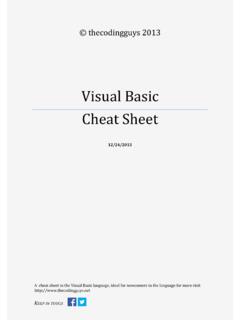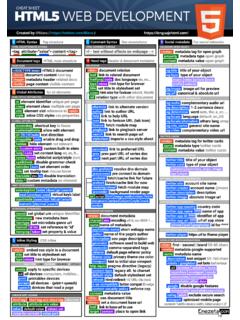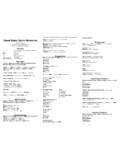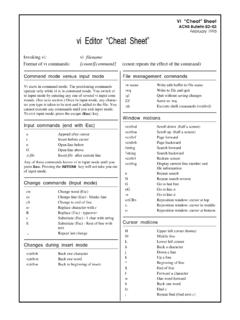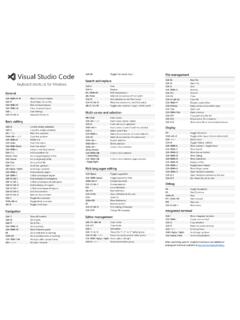Transcription of C# Basics Cheat Sheet (1 of 4) - BeginCodingNow.com
1 C# Basics Cheat Sheet (1 of 4) Introduction to C# The C# language was developed by Microsoft for the .NET framework. C# is a completely-rewritten language based on C Language and C++ Language. It is a general-purpose, object-oriented, type-safe platform-neutral language that works with the .NET Framework. visual Studio (VS) visual Studio Community 2017 is a free download from Microsoft. To create a new project, go to File New Project in visual there select the visual C# template type in the left frame. Then select the Console App template in the right frame. At the bottom of the window configure the name and location of the project. Click OK and the project wizard will create your project. C# Hello World (at the Console) using System; namespace ConsoleApp1 { class Program { static void Main(string[] args) { ("Hello World"); /* this comment in C# is ignored by compiler */ /* a multi- line comment that is ignored by the compiler*/ } } } Ctrl+F5 will run the program without the debug mode.
2 The reason why you do not want to choose the Start Debugging command (F5) here is because the console window will then close as soon as the program has finished executing, unless you use (); at the end. There are several methods and properties of console. You can change colors and put a Title on the console. Add this to the Main() to use your namespace, which may be your solution and project name also. Type myType = typeof(Program); = ; = ; = 180; // max might be 213 (180 is very wide) A Few Code Snippets in VS Code Snippet Description cw ()prop public int MyProperty { get; set; }ctor Constructor Ctrl+K+C/Ctrl+K+U Comment & un-comment a selected code block F12 Go to Definition ReSharper is a plug- in for visual Studio that adds many code navigation and editing features. It finds compiler errors, runtime errors, redundancies, and code smells right as you type, suggesting intelligent corrections for them.
3 Common Language Runtime (CLR) A core component of the .NET Framework is the CLR, which sits on top of the operating system and manages program execution. You use the .NET tools (VS, compiler, debugger, ASP and WCF) to produce compiled code that uses the Base Class Library (BCL) that are all used by the CLR. The compiler for a .NET language takes a source code (C# code and others) file and produces an output file called an assembly (EXE or DLL), which isn t native machine code but contains an intermediate language called the Common Intermediate Language (CIL), and metadata. The program s CIL isn t compiled to native machine code until it s called to run. At run time, the CLR checks security, allocates space in memory and sends the assembly s executable code to its just-in -time (JIT) compiler, which compiles portions of it to native (machine) code. Once the CIL is compiled to native code, the CLR manages it as it runs, performing such tasks as releasing orphaned memory, checking array bounds, checking parameter types, and managing exceptions.
4 Compilation to native code occurs at run time. In summary, the steps are: C# code assembly (exe or dll) & BCL CLR & JIT compiler machine code operating system Declaration and Assignment In C#, a variable must be declared (created) before it can be used. To declare a variable, you start with the data type you want it to hold followed by a variable name. A value is assigned to the variable by using the equals sign, which is the assignment operator (=). The variable then becomes defined or initialized. Data Types A primitive is a C# built-in type. A string is not a primitive type but it is a built-in type. Primitive Bytes Suffix Range Sys Type bool 1 True or False Boolean char 2 Unicode Char byte 1 0 to 255 Byte sbyte 1 -128 to 127 SByte short 2 -32,768 to 32,767 Int16 int 4 -231 to 231-1 Int32 long 8 L 263 to 263 1 Int64 ushort 2 0 to 216-1 UInt16 uint 4 U 0 to 232-1 UInt32 ulong 8 UL 0 to 264-1 UInt64 float 4 F + x 10-45 to + x 1038 Single double 8 D + x 10-324 to + x 10308 Double decimal 16 M + x 10-28 to + x 1028 Decimal The numeric suffixes listed in the preceding table explicitly define the type of a literal.
5 By default, the compiler infers a numeric literal to be either of type double or an integral type: If the literal contains a decimal point or the exponential symbol (E), it is a double. Otherwise, the literal s type is the first type in this list that can fit the literal s value: int, uint, long, and ulong. Integral Signed (sbyte, short, int, long) Integral Unsigned (byte, ushort, uint, ulong) Real (float, double, decimal) ( ()); // ( ()); // Type Default Value Reference/Value All numbers 0 Value Type Boolean False Value Type String null Reference Type Char \0 Value Type Struct Value Type Enum E(0) Value Type Nullable null Value Type Class null Reference Type Interface Reference Type Array Reference Type Delegate Reference Type Reference Types & Value Types C# types can be divided into value types and reference types. Value types comprise most built-in types (specifically, all numeric types, the char type, and the bool type) as well as custom struct and enum types.
6 There are two types of value types: structs and enumerations. Reference types comprise all class, array, delegate, and interface types. Value types and reference types are handled differently in memory. Value types are stored on the stack. Reference types have a reference (memory pointer) stored on the stack and the object itself is stored on the heap. With reference types, multiple variables can reference the same object, and object changes made through one variable will affect other variables that reference the same object. With value types, each variable will store its own value and operations on one will not affect another. Strings A string is a built-in non-primitive reference type that is an immutable sequence of Unicode characters. A string literal is specified between double quotes. The + operator concatenates two strings. A string preceded with the $ character is called an interpolated string which can include expressions inside braces { } that can be formatted by appending a colon and a format string.
7 String s = $"255 in hex is {byte .MaxValue:X2}"; Interpolated strings must complete on a single line, unless you also specify the verbatim string operator. Note that the $ operator must come before @ as shown here: int x = 2; string s = $@"this spans { x} line s in code but 1 on the console.";Another example: string s = $@"this spans {x} lines in code and 2 lines on the console."; // at left side of editor string does not support < and > operators for comparisons. You must instead use string s CompareTo method, which returns a positive number, a negative number, or zero. Char C# s char type (aliasing the type) represents a Unicode character and occupies two bytes. A char literal is specified inside single quotes. char MyChar = 'A' ; char[] MyChars = { 'A', 'B' , 'C' }; (MyChar); foreach ( char ch in MyChars) { (ch); } C# Basics Cheat Sheet (2 of 4) Escape Sequences Escape sequences work with chars and strings, except for verbatim strings, which are proceeded by the @ symbol.
8 ("Hello\nWorld"); // on two lines ("Hello\u000 AWorld"); // on two lines char newLine = '\n'; ("Hi" + newLine + "World"); // on two lines The \u (or \x) escape sequence lets you specify any Unicode character via its four-digit hexadecimal code. Char Meaning Value \ Single quote 0x0027 \ Double quote 0x0022 \\ Backslash 0x005C \0 Null 0x0000 \a Alert 0x0007 \b Backspace 0x0008 \f Form feed 0x000C \n New line 0x000A \r Carriage return 0x000D \t Horizontal tab 0x0009 \v Vertical tab 0x000B Verbatim string literals. A verbatim string literal is prefixed with @ and does not support escape sequences. string myPath = @"C: \temp\"; string myPath = "C: \\temp\\"; Constants A local constant is much like a local variable, except that once it is initialized, its value can t be changed. The keyword const is not a modifier but part of the core declaration and it must be placed immediately before the type.
9 A constant is a static field whose value can never change. A constant is evaluated statically at compile time and the compiler literally substitutes its value whenever used (rather like a macro in C++). A constant can be any of the built-in numeric types, bool, char, string, or an enum type. const int myNumber = 3; Expressions An expression essentially denotes a value. The simplest kinds of expressions are constants (such as 45) and variables (such as myInt). Expressions can be transformed and combined with operators. An operator takes one or more input operands to output a new expression. Operators Operators are used to operate on values and can be classed as unary, binary, or ternary, depending on the number of operands they work on (one, two, or three). They can be grouped into five types: arithmetic, assignment, comparison, logical and bitwise operators. The arithmetic operators include the four basic arithmetic operations, as well as the modulus operator (%) which is used to obtain the division remainder.
10 The second group is the assignment operators. Most importantly, the assignment operator (=) itself, which assigns a value to a variable. The comparison operators compare two values and return either true or false. The logical operators are often used together with the comparison operators. Logical and (&&) evaluates to true if both the left and right side are true, and logical or (||) evaluates to true if either the left or right side is true. The logical not (!) operator is used for inverting a Boolean result. The bitwise operators can manipulate individual bits inside an integer. A few examples of Operators. Symbol Name Example Overloadable? . Member access No () Function call x() No [] Array/index a[x] Via indexer ++ Post-increment x++ Yes -- Post-decrement x-- Yes new Create instance new Foo() No ?. Null-conditional x?.y No ! Not !x Yes ++ Pre-increment ++x Yes -- Pre-decrement --x Yes () Cast (int)x No == Equals x == y Yes !
